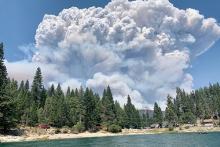Timothy S. White, research professor in Penn State’s Earth and Environmental Systems Institute, was elected a Fellow of the Geological Society of America. White is one of 50 newly elected Fellows receiving the honor in recognition of their sustained records of distinguished contributions to the geosciences and the Geological Society of America.
Fires in semi-arid forests in the western United States tended to burn periodically and at low severity until the policy of fire suppression put an end to these low-intensity events and created the conditions for the destructive fires seen today. Understanding the benefits of these periodic fires and the forest structure that they maintained may help land managers and communities avert megafires in the future, according to researchers.
Machine learning techniques may help scientists better understand the intricate chemistry of streams and monitor broader environmental conditions, according to a team of researchers.
A combination of a once-debunked 19th-century identification of a water-carrying iron mineral and the fact that these rocks are extremely common on Earth, suggests the existence of a substantial water reservoir on Mars, according to a team of geoscientists.
Every year the GBGM executive committee selects exceptional scholars to receive awards for their accomplishments in research, education/mentoring, and service in geobiology.
Alan Taylor, professor of geography and ecology, will serve as interim director of the Penn State Earth and Environmental Systems Institute (EESI) while director Susan Brantley is on sabbatical. His appointment began July 1.




